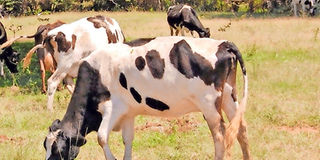Faster, simple way to keep milk records

Dairy cattle graze in farm. Well-documented records of individual cows offer good marketing tools since they give one bargaining confidence and ask for premium price, especially those with lactation certificates. FILE PHOTO | NMG
What you need to know:
- If done correctly, milk production recording is a powerful tool that is capable of tracking production performance and profitability in the herd.
- With milk production records, you can easily identify low producing animals and probably put them on a special diet or cull.
- The real challenge in most farm milk recording systems is taking the information collected every day and putting it into a form that can later make meaning.
- If you prefer to keep records simply with a pen and paper, purchase loose-leaf record books and get the job done.
Milk production record is an important tool on any dairy farm, yet some farmers still ignore it or those who use it don’t do it correctly defeating the purpose.
The process of milk recording may vary on farms but generally it involves capturing yields and composition of milk produced by an individual lactating cow.
If done correctly, milk production recording is a powerful tool that is capable of tracking production performance and profitability in the herd.
Well-documented records of individual cows offer good marketing tools since they give one bargaining confidence and ask for premium price, especially those with lactation certificates.
With milk production records, you can easily identify low producing animals and probably put them on a special diet or cull.
That is, keeping milk records will allow the farmer look at how management changes such as nutrition impact on the performance of the herd. Unit costs of production can also be easily monitored.
Keeping milk records successfully begins with individual cow identification. Like humans, cows need names or national identification cards for easy identification.
These names or unique IDs are imperative in record-keeping. Then, select a record-keeping method that familiarises your farm management habits or works best for your farm assistants.
The real challenge in most farm milk recording systems is taking the information collected every day and putting it into a form that can later make meaning.
Indeed, record-keeping does mean more efforts on the part of the dairy farmer but it does not matter what you use for keeping records.
ECONOMIC APPRAISAL OF DAIRY ENTERPRISE
The real value lies in the record’s ability to be converted into information and influence decisions that can support and improve farm efficiency.
There are many tools available in the market such as computer software programmes and spreadsheets for modern day farming.
These are the most efficient form of record-keeping since they enable relevant information to be entered quickly, easily and the data analysed to generate simple or detailed production summaries.

A sample milk record. Well-kept milk records can greatly contribute to the economic appraisal of a dairy enterprise. TABLE | COURTESY
But computer cattle management software are not all that is required to maintain accurate farm records. Next to them are pocket record books designed for recording milk output in the everyday setting anytime milking takes place.
If you prefer to keep records simply with a pen and paper, purchase loose-leaf record books and get the job done.
However, before going this option, the records must be decided so that the details captured facilitate future analysis and interpretation.
In this option, often the end use is not well thought out and the usefulness of the records is severely impaired.
Organise the records to contain cow identification numbers, dates and other information useful and record these data under the corresponding individual lactating cows.
Use of cow cards is another exciting option, especially for smallholder and medium-scale dairy farms.
There is more in milk records than just daily milk yield per animal or total herd. Milk records entail other information such as milk quality content (butter fat, protein and solid non-fat), lactation length, lactation yield, milk fed to calves, milk used at home, milk lost post-milking (quantifiable spillages or spoilt milk), milk sold and price, among other aspects.
Figures do not lie. Well-kept milk records can greatly contribute to the economic appraisal of a dairy enterprise.
Above is a sample milk record. The format can be changed horizontally or vertically depending on the herd size.





